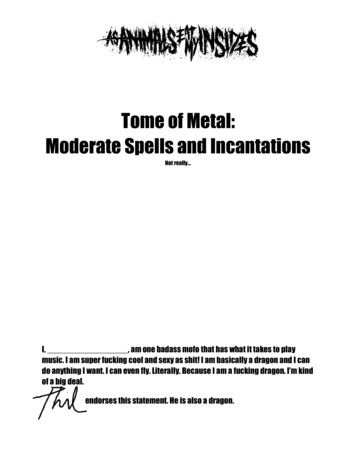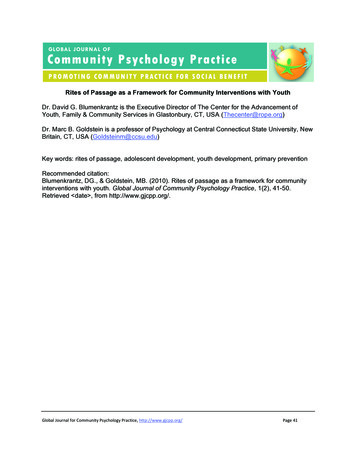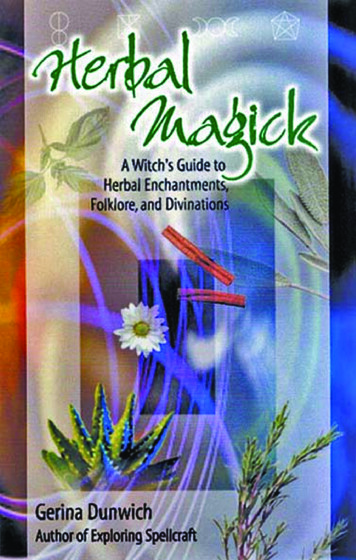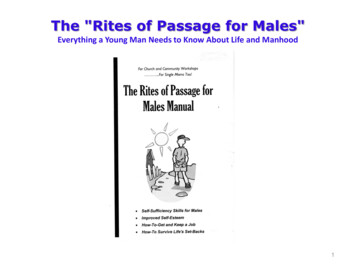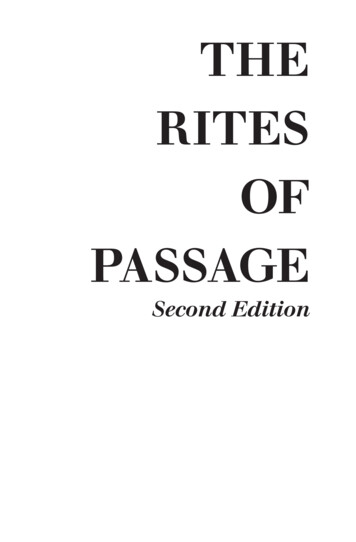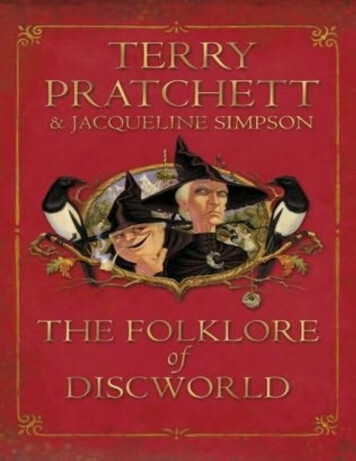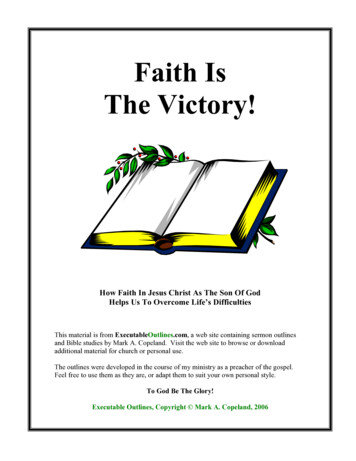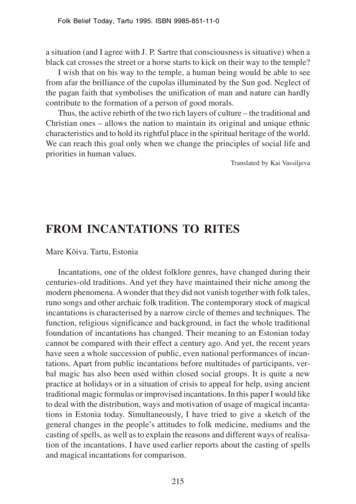
Transcription
Folk Belief Today, Tartu 1995. ISBN 9985-851-11-0a situation (and I agree with J. P. Sartre that consciousness is situative) when ablack cat crosses the street or a horse starts to kick on their way to the temple?I wish that on his way to the temple, a human being would be able to seefrom afar the brilliance of the cupolas illuminated by the Sun god. Neglect ofthe pagan faith that symbolises the unification of man and nature can hardlycontribute to the formation of a person of good morals.Thus, the active rebirth of the two rich layers of culture – the traditional andChristian ones – allows the nation to maintain its original and unique ethniccharacteristics and to hold its rightful place in the spiritual heritage of the world.We can reach this goal only when we change the principles of social life andpriorities in human values.Translated by Kai VassiljevaFROM INCANTATIONS TO RITESMare Kõiva. Tartu, EstoniaIncantations, one of the oldest folklore genres, have changed during theircenturies-old traditions. And yet they have maintained their niche among themodern phenomena. A wonder that they did not vanish together with folk tales,runo songs and other archaic folk tradition. The contemporary stock of magicalincantations is characterised by a narrow circle of themes and techniques. Thefunction, religious significance and background, in fact the whole traditionalfoundation of incantations has changed. Their meaning to an Estonian todaycannot be compared with their effect a century ago. And yet, the recent yearshave seen a whole succession of public, even national performances of incantations. Apart from public incantations before multitudes of participants, verbal magic has also been used within closed social groups. It is quite a newpractice at holidays or in a situation of crisis to appeal for help, using ancienttraditional magic formulas or improvised incantations. In this paper I would liketo deal with the distribution, ways and motivation of usage of magical incantations in Estonia today. Simultaneously, I have tried to give a sketch of thegeneral changes in the people’s attitudes to folk medicine, mediums and thecasting of spells, as well as to explain the reasons and different ways of realisation of the incantations. I have used earlier reports about the casting of spellsand magical incantations for comparison.215
Folk Belief Today, Tartu 1995. ISBN 9985-851-11-0The Use of Incantations in Folk MedicineIn the past century it was only various craftsmen – smiths who pulled outteeth, cuppers, fortune-tellers, palmists – who used to heal people withoutusing some magical formulas. According to the bearers of tradition an act ofcuring without an accompanying magical incantation was not really effective.Even some craftsmen helpers applied some verbal magic, in order to improvethe results of an act of curing. Archive records show that in the beginning ofthe 20th century quackery and the use of charms seem to have been widespread. This is corroborated by both the earlier records as well as by the reminiscences of the informants who were questioned in the 1970’s and 80’s. So,about 700 folk healers have practised in the parish of Võnnu within the past 100years; they treated different human and animal diseases.1 Mostly their healingrites were accompanied by incantations. The students of medicine who werelooking for folk healers in the district of Pärnu in the 1930’s found a greatnumber of them.2 In the archive records there are memorates about half of thehealers of that period, showing that incantations were quite commonly used intheir practice. One of such collecting expeditions has produced a copy of anote-book with about two and a half hundred incantations, which belonged toAnna Kuusik, a witch doctor who in those times practised in Pärnu and latermoved to Häädemeeste. She lent it to a student for copying. In the 1960’s thesame note-book, with the explanatory remarks by Anna Kuusik, was copied forthe funds of the Folklore Archives by Marta Mäesalu, the correspondent atHäädemeeste. So, the stock of incantations, later complements and shifts in thevocabulary, as well as the attitudes of the healer herself, are quite easy toobserve and date.3Folk Medicine and Official MedicineThe frequency of seeing folk healers and witch doctors evidently declinedin the 1930’s. In those times witch doctors could be found in large numbers insome places only, preferably in large marshy and swampy or woody areas, butalso in some poor parishes. People had already developed a preference forlicensed doctors. They preferred to go to a hospital to deliver a baby, snakebites and erysipelas were also shown to doctors with medical training (although ‘home-spun’ doctors were quite successful in curing both). A traditionbearer has described the situation in the following way:In former times L. also used to deliver babies, but in 1925 or so,when I came here, she didn’t any more, then women used to go totown. (RKM II 393, 119 (4) Kambja (1985)).216
Folk Belief Today, Tartu 1995. ISBN 9985-851-11-0A breakthrough in the people’s attitudes is primarily connected with theintroduction of a new generation of medicines – the antibiotics.4 Since then,folk and official medicine, though branches from the same root, have beendrifting widely apart from each other. Stein Mathiesen has explained the difference between folk medicine and official medicine with the help of the followingtable:5biomedicinefolk ivinationscientific lawssupernatural powersmedication, acleAny contrasting of phenomena with each other brings into light their newaspects and essential differences. Even such schematic systematisation as thepresent one helps to illustrate different possibilities of healing and being healed,and suggests the evident merging points. This treatment clearly manifestsgreat mental efforts and the stimulation of the patient’s willingness to be healed,both being spheres where the folk medicine surpasses the official one.So we can see that folk medicine pays more attention to the human psychicstate and his untouched stores of energy, his wish to regain his health andwillingness to be healed through purifying one’s spiritual being. S. Mathiesenstresses the reliance of the official medicine on biochemical treatment of thepatient and on the recognised laws of nature. The methods and remedies of theofficial medicine are sanctioned by social institutions, the treatment is to resultin the restoration of the former health of the patient. The opposite side is basedon the officially not recognised mental experience, supernatural forces andunrecognised laws of nature. From the remedies only verbal magic has beenstressed, healing is associated with the confident expectation of a wonder. Thegiven classification is somewhat one-sided. Folk medicine and official medicinehave evolved in mutual interaction and for a lengthy period of their development they have been fairly similar to each other. Verbal magic has hardly everbeen used alone, isolated from other techniques of treatment. Various othermethods of treatment were always used parallelly with it, and often even preferred to it, including herbal medicines, massage, etc. For quite a while it hasbeen a common practice to use medicines bought from a chemist’s shop, or tocombine these with home-made remedies. Some new practices and informationhas come in from the traditions and experience of other nations. Many techniques of manual therapy, such as correction of the patient’s energy with the217
Folk Belief Today, Tartu 1995. ISBN 9985-851-11-0healer’s hands, etc., have been interpreted in a novel way. In this century theverbal magic has lost its position and is gradually disappearing from the set oftechniques of folk medicine. Today the diagnosing methods of a professionalphysician may hardly differ from those of a witch doctor – in their relations withthe patients both are relying on their own experience, professional skills andintuition. The medical knowledge of folk healers is often amateurish or homespun, but quite extensive at that. In diagnosing a disease, folk medicine used,and still uses, various methods that correlate with the official medicine (palpation, anamnesis, in the last decades also consultations with ‘official’ doctors,lab tests, etc.) Many folk healers demand that patients come to them with adiagnosis and a note from an official physician suggesting the patient to seethe folk healer. One of such healers is Laine Roht, also known as the witch ofKaika, who believes that the process of healing is more successful when bothsides unite their forces to help the patient regain his/her health.6What made people forsake the methods of folk medicine was the efficacy ofbiochemical remedies. It seems that only in isolated farms in bogs and deepforests, and in cases of certain illnesses, the traditional medicine managed toretain its priority. The spread of antibiotics brought about an irreversible withdrawal from the (oral) tradition. The skills and traditions of healing, accumulated in the course of centuries, tested through empirical experience and approved by our ancestors’ families (or even wider social groups), were nowfalling into oblivion, people relied to them only in case of colds and othercommon diseases. In most cases they still preferred treatment with antibiotics.The feeling of insecurity before, during, and after World War II, relativesand friends reported missing, repeated repressive actions from the government, were the factors that raised diviners and clairvoyants to a special status.The position of witch doctors, however, was influenced by the regular medicalnetwork rather than historical events. Because of the good reputation of hospitals people would not give birth to babies or treat serious diseases at home.Self-treatment was considered out-of-date, it belonged to the past. Officialmedicine gained credit for vaccination of infants that nearly eliminated fatalcontagious infant diseases. I remember from my childhood old people tellingstories about an outbreak of poliomyelitis in Estonia and their feelings of reliefand gratitude for the vaccine that saved them miraculously.Back to Folk Medicine?It was probably the low selling price of medicines that conduced to theirexcessive usage. New remedies were attributed miraculous qualities. Peoplethought that with these they could be cured of hopeless cases and incurablediseases, stop chronic inflammations and other serious illnesses. Optimistic218
Folk Belief Today, Tartu 1995. ISBN 9985-851-11-0A text from the registration book of Laine Roht. The text is: Dear Healer!I'm visiting you for the second time already. The pains are gone and I hope tobe wholly cured. How nice it is that there is someone to whome to come withone's troubles! I wish to you strong health and all the best!prognoses of the 1960’s foresaw the decline and eventual disappearance of thediseases before drugs. A similar atmosphere of the expectation of a wondersurrounded the then very common usage of chemicals. The latter was to procure good crops and to free us from all those unnecessary and hostile beingswho caused illness. DDT and other poisons, for example, quite unmistakablyreduced the number of ‘useless’ (so they claimed) birds and other creatures.People were not actually aware of the accumulation of chemicals in a livingorganism. The result was allergies and other diseases difficult to cure; thesewere the most frequent complaints of people who went to see folk healerswithin the past few decades. The crisis of biochemical medicine was furtherpromoted by a rapid distribution of epidemics, mutated germs and carcinomas.As an old lady said: Diseases are getting more and more, never have therebeen so many of them.219
Folk Belief Today, Tartu 1995. ISBN 9985-851-11-0Folk doctors in their treatment have always paid much attention to attemptsto find out the cause of origin of the disease: together with the patient they aretrying to specify that particular object or situation that may have caused themalady (the healer suggests different variants).7 Again, folk medicine tends tostress the so-called mental explanations of diseases (breaking of some rules ofbehaviour, wrong way of life, modern equivalents for the evil eye or curses),seconded by geographical ones (badly chosen places of living, veins of water,evil eye, etc.)The official medicine prescribed each patient an allotted time of 10 minutesfor consultations. During that time the physician had to communicate with thepatient, fill in the case history, and so he or she had no time to lift his/her eyesfrom the paperwork. Such an anonymous and hasty communication precludedany chance for a mental contact and joint discussion between these two aboutthe probable explanation of the origin of the disease. In most cases there wasno time left to discuss the symptoms that were troubling the patient, or to try tofind out the psychological or other factors that might have assisted the development of the disease. The narrow specialisation of doctors that was quitecommon in those days gave rise to folk legends about the patients’ odysseysto different specialists, each of whom knew only a certain part of the patientand gave the patient a different diagnosis. Apart from the limited and superficial contacts between doctors and patients, such a specialisation degraded theoutpatient clinics as well. It was much easier for patients, including those withpsychosomatic diseases, to find contact with folk healers who could sparemuch more time and attention for them, treated them as personalities, communicated with them in an open way. Even in complicated cases the patient got a fullround-up explanation for the nature, origin and cause of the disease. Hints atsupernatural powers that the folk healer was supposed to control and use tocure the patient aroused hopes for miraculo
FROM INCANTATIONS TO RITES Mare Kõiva. Tartu, Estonia Incantations, one of the oldest folklore genres, have changed during their centuries-old traditions. And yet they have maintained their niche among the modern phenomena. A wonder that they did not vanish together with folk tales, runo songs and other archaic folk tradition. The contemporary stock of magical incantations is characterised by .
